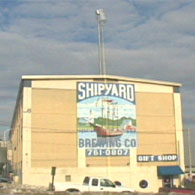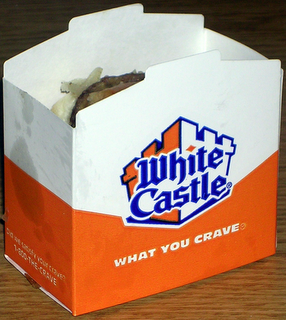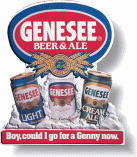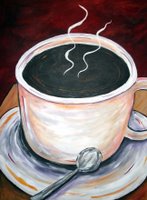Expanding Our Horizons
Wisconsin on tap: A road trip with a brew
A little somethin' from the Chicago Tribune for our Midwestern readers. We think this a region that often gets overlooked, with all the love on the coasts. Reading it makes us itch for a roadtrip for some reason. It also makes us thirsty.That was the typical response I got from brewers during a series of microbrewery road trips around Wisconsin that lasted from April into July.
I called it the ultimate pils-grimage, a sacred journey to meet the brewmasters and sample the suds at the state's 70-plus breweries and brewpubs. From my home in Madison, Wis., I hit all but a few of them in a half dozen looping trips. I also learned some related local lore, like where the fresh cheese curds were and who was doing the Friday fish fry.
My first road trip for beer was back in the late '80s when a group of college buddies and I set off from Green Bay on a two-hour drive to Stevens Point with the sole intention of touring the Point Brewery. At that time Bilko, a retired brewery employee who led the tours on Saturday mornings, prodded me in the shoulder with a finger as he asked, "And ya know what kraeusening is, don'tcha?" I had no idea.
This series of trips began with a map of Wisconsin, on which I marked up the locations (Dallas, Wis.--who knew?) of various microbrewers and brewpubs, with the intention of creating a road-trip guidebook (see end for information).
Whether you are just popping up to Milwaukee or Madison for the day, or taking a long weekend up in Chetek, Minocqua or Door County, there are beers here that any beer fan should not pass up a chance to try. Many of these brews you won't find even at a liquor store across the street from the producer.
All the breweries except Rush River Brewery in Maiden Rock have some kind of tour and samples. Nearly all the brewpubs will give you a tour or at least chat about their system if it is very small (and it often is), but that often depends on the availability of the brewmaster. In a place like Hops Haven Brew Haus in Sheboygan, the brewmaster is also the owner, bartender, plumber and janitor.
Milwaukee, the city that beer made famous, is a good place to start. Miller still turns out barrels in seven digits every year, and few are the countries around the world where you can't get your hands on some. But there are also a good number of brewpubs in the area distributing most or even all of their production over the bar.
Sprecher Brewing Co., which started brewing in 1985, is the oldest of the microbreweries in Wisconsin, and neighborhood hangout Stonefly Brewing is the newest of the brewpubs (stop in for live music and check out the tap handles, works of metal art done up by one of the bartenders). If you have to choose, Milwaukee's Lakefront Brewery arguably has the best tour (with samples before, during and after)--and on Fridays, you can stay for the fish fry complete with live polka band.
But if you have time for more, take a ride on the Brew City Queen (414-283-9999), a pontoon boat that on weekends from mid-May through September does three-hour cruises with three stops--Lakefront, Rock Bottom Restaurant and Brewery and the Milwaukee Ale House (also the temporary home to the Museum of Beer and Brewing).
Another way to effortlessly hit multiple brewpubs is the Milwaukee trolley--the free ride passes close to Rock Bottom, Milwaukee Ale House and Water Street Brewery, as well as other major attractions downtown.
Madison is not to be left behind. The Great Dane Pub and Brewery and JT Whitney's Pub and Brewery have very loyal followings (for good reason), and Capital Brewery in nearby Middleton probably has bottles at your corner liquor store. None is to be missed. The most recent arrival is Ale Asylum where the beer is "Brewed in Sanity." Brewmaster Dean Coffey, who made a name for himself when he brewed at Angelic Brewpub, has a pale ale called Hopalicious, which caters to hopheads, and a few delightful Belgian ales that move up the scale on alcohol.
Just these pubs warrant a couple of days; add a trip to Lake Louie Brewing in the woods in nearby Arena or the Grumpy Troll Brewpub in Mt. Horeb or New Glarus Brewery (see below) to the southwest, and you could make quite a long weekend.
But if you've got more time and a full tank of gas, there are some goldmines farther afield.
Minocqua Brewing Co. is right downtown and lakeside in that popular tourist town. Besides offering great handcrafted beers it is also a great place to go for a fish fry.
If you are going all the way to Lake Superior, don't miss Ashland's South Shore Brewery or Twin Ports Brewing in Superior. If you're up here to camp, grab a growler (a half-gallon glass jug refillable at your local brewpub; pictured on the front page is one from Stone Cellar Brewpub in Appleton) and take it along.
Marshfield has a hit with Central Waters Brewery which is married to 14th Street Restaurant, the best eats in town. Mudpuppy Porter is quite popular, and if you want something really different, try their Imperial Stout--aged six months in old bourbon barrels.
And now for some Wisconsin microbrewery/brewpub superlatives and trivia:
Smallest brewery: It may surprise you (or not, considering the state), but the student center at the University of Wisconsin-Platteville offers a lager and a pale ale brewed on site.
Largest microbrewery: New Glarus Brewery--maker of Spotted Cow, Fat Squirrel and Totally Naked--rolls out about 40,000 barrels per year. They offer self-guided audio tours of the brewery. Next summer, the tours will move to a second facility on the other side of this little Swiss town, which will allow them to triple production to 120,000 barrels.
Most remote: Nicolet Brewing in the town of Florence is open only on the weekends but is a must stop. Florence is as far northeast as one can get without being in Michigan. In Florence County, every town, including the namesake county seat, is unincorporated. Brewmaster Art Lies will set you up with a fine pint and is an endless font of tales, most of them tall.
Most brewpubs per capita: If you don't count the travelers who come here for a variety of outdoors activities throughout the summer--and the Birkebeiner cross-country ski marathon in winter--Hayward (pop. 2,245) surely is a contender with Angry Minnow Brewery and Muskie Capital Brewery. As if the giant muskie at the Fresh Water Fishing Hall of Fame wasn't enough reason to come.
Where would Al Capone drink? Two of the brewpubs--Shipwrecked Brew Pub in Door County's Egg Harbor and Bugsy's Sports Bar (Brown Street Brewery) in Rhinelander--have or had tunnels leading out of their basements, and local legend has it Capone used them to escape the Feds.
Only brewery with a drive-up window and playland: Falls Brewing in Oconto Falls, which set up a brewery and bottling operation in an old Hardee's. Sorry, but neither are currently in use.
----------
Kevin Revolinski is the author of "The Wisconsin Beer Guide: A Travel Companion" (Tynan's Independent Media, $21.95). If you can't find it in bookstores, it's available online at www.wisconsinbeerguide.com.








 In the maibock category,
In the maibock category, 


 tasting events in Boston, Chicago, Charleston, SC, Colorado Springs, CO, Dallas, Las Vegas, New York City, Phoenix, Washington, DC, and other locations. The winning brew will join the 12-pack Samuel Adams Brewmaster’s Collection in January 2007. This is actually the second annual tasting event, and Marketing Blurb regrets we missed joining 11,000 beer enthusiasts at more than 430 tasting events to select Samuel Adams Brown Ale over Samuel Adams Bohemian Pilsner for this year's Brewmaster's Collection. Okay, now—we have already forgotten which beer is which, so serve us another round of each—thanks. Cheers to
tasting events in Boston, Chicago, Charleston, SC, Colorado Springs, CO, Dallas, Las Vegas, New York City, Phoenix, Washington, DC, and other locations. The winning brew will join the 12-pack Samuel Adams Brewmaster’s Collection in January 2007. This is actually the second annual tasting event, and Marketing Blurb regrets we missed joining 11,000 beer enthusiasts at more than 430 tasting events to select Samuel Adams Brown Ale over Samuel Adams Bohemian Pilsner for this year's Brewmaster's Collection. Okay, now—we have already forgotten which beer is which, so serve us another round of each—thanks. Cheers to 






























